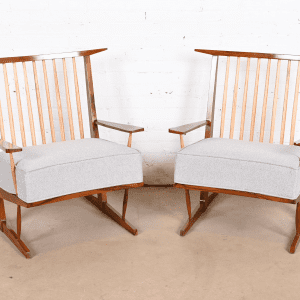The Designer At A Glance
George Nakashima changed the way that many designers worked with wood. He believed that wooden furniture takes on a life of its own, and encouraged designers to have more direct contact with the natural materials they use.
The Life Behind The Design
It should come as no surprise that one of the 20th century’s foremost woodworkers grew up surrounded by the natural beauty of the Pacific Northwest. George Nakashima was born in Spokane, Washington in 1905, and his fascination with wood began at an early age.
Along with studying forestry, Nakashima earned a Master’s in architecture at the University of Washington. With his degree in hand, he sold off his car and started a worldwide trip — during which he practiced and expanded his craft in Paris, Tokyo and India.
Upon returning to the U.S. in 1942 in the midst of World War II, Nakashima and his family were imprisoned and forcibly relocated to a Japanese American internment camp in Idaho. There he learned traditional Japanese carpentry techniques from another detained man, refocusing him on the intimate connection between artist and material.

Blending such varied influences from American Modern styles to traditional Japanese woodworking, Nakashima ushered in a new wave of appreciation for wood in particular. He believed that natural materials had individuality that should be studied, understood and respected. Many of his tables, for instance, have natural, unfinished edges to preserve the wood’s individuality.
While Nakashima died in 1990, his home near New Hope, Pennsylvania still stands as a testament to his mastery of woodworking. The George Nakashima House, Studio and Workshop was recognized as a National Historic Landmark in 2014, and is open to the public.
Notable Works: Altar for Peace
Aside from Nakashima’s timeless masterpieces, his legacy also includes the Nakashima Foundation for Peace. Nakashima considered himself a “Hindu Catholic Shaker Japanese American” — a man of many backgrounds striving for greater connection between humankind.
“A symbol is needed—something tangible like the toe of St. Peter’s statue in the Vatican,” Nakashima wrote. “It will be a symbol, a token of man’s aspirations for a creative and beautiful peace, free of political overtones; an expression of love for his fellow man.”
The symbol came to Nakashima in the form of a walnut tree, from which he fashioned a 12-foot-long table he named the Altar for Peace. The table was placed in the Cathedral of St. John the Divine in New York City, where it was blessed by holy people of all faiths in the company of diplomats from around the world.

Nakashima imagined a total of six Altars of Peace, one for each habitable continent, but he only completed one before his passing. Today there are three Sacred Peace Tables across the globe, each built in Nakashima’s workshop — Nakashima’s original in NYC for North America, one in Moscow for Europe, and one in Auroville, India for Asia. As of writing, there is a fourth table being planned in Cape Town for Africa.
Liberty & 33rd & George Nakashima
Nakashima’s unparalleled aptitude for woodworking is prevalent across his pieces in our collection. Find your next Nakashima piece at Liberty & 33rd, and admire the individuality of the natural form.
-
 George Nakashima for Widdicomb Origins Collection East Indian Laurel Wood Drop-Leaf Dining Table, Newly Restored
George Nakashima for Widdicomb Origins Collection East Indian Laurel Wood Drop-Leaf Dining Table, Newly Restored -
 George Nakashima Sculpted East Indian Laurel Wood Sliding Door Sideboard Credenza for Widdicomb, Newly Restored
George Nakashima Sculpted East Indian Laurel Wood Sliding Door Sideboard Credenza for Widdicomb, Newly Restored -
 George Nakashima East Indian Laurel Wood Bookcase or Hutch for Widdicomb, Circa 1960
George Nakashima East Indian Laurel Wood Bookcase or Hutch for Widdicomb, Circa 1960 -
 George Nakashima for Widdicomb Origins Collection Sculpted Walnut Extension Dining Table, Newly Restored
George Nakashima for Widdicomb Origins Collection Sculpted Walnut Extension Dining Table, Newly Restored -
 George Nakashima East Indian Laurel Wood Side Table or Cocktail Table for Widdicomb, Newly Restored
George Nakashima East Indian Laurel Wood Side Table or Cocktail Table for Widdicomb, Newly Restored -
 George Nakashima Monumental Sculpted Walnut Dresser for Widdicomb, Newly Restored
George Nakashima Monumental Sculpted Walnut Dresser for Widdicomb, Newly Restored -
 Conoid Lounge Chairs in Sculpted Walnut After George Nakashima, Pair
Conoid Lounge Chairs in Sculpted Walnut After George Nakashima, Pair -
 George Nakashima Sculpted Walnut Gentleman’s Chest for Widdicomb, Circa 1960
George Nakashima Sculpted Walnut Gentleman’s Chest for Widdicomb, Circa 1960 -
 George Nakashima East Indian Laurel Wood Gentleman’s Chest for Widdicomb, Newly Restored
George Nakashima East Indian Laurel Wood Gentleman’s Chest for Widdicomb, Newly Restored









